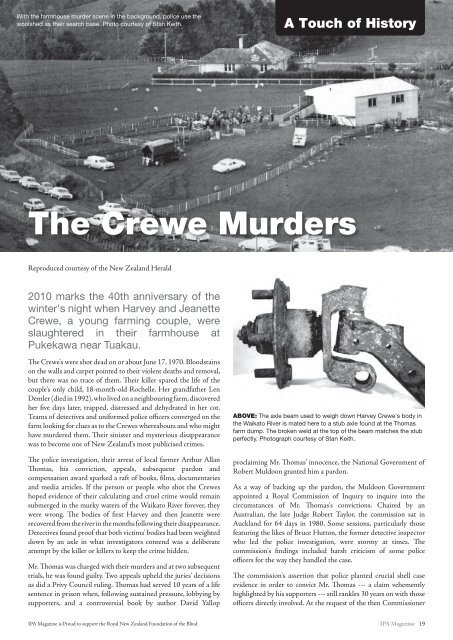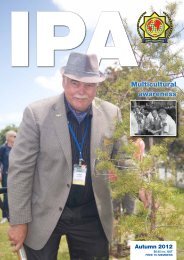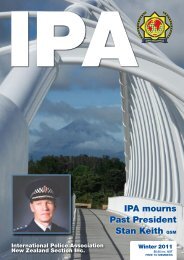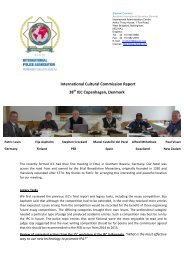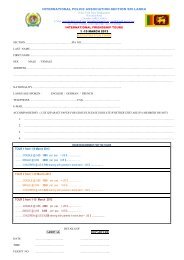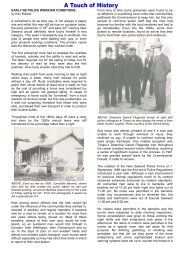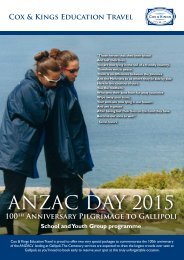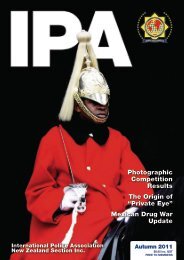The Crewe Murders - Ipa.org.nz
The Crewe Murders - Ipa.org.nz
The Crewe Murders - Ipa.org.nz
Create successful ePaper yourself
Turn your PDF publications into a flip-book with our unique Google optimized e-Paper software.
With the farmhouse murder scene in the background, police use the<br />
woolshed as their search base. Photo courtesy of Stan Keith.<br />
A Touch of History<br />
<strong>The</strong> <strong>Crewe</strong> <strong>Murders</strong><br />
Reproduced courtesy of the New Zealand Herald<br />
2010 marks the 40th anniversary of the<br />
winter's night when Harvey and Jeanette<br />
<strong>Crewe</strong>, a young farming couple, were<br />
slaughtered in their farmhouse at<br />
Pukekawa near Tuakau.<br />
<strong>The</strong> <strong>Crewe</strong>'s were shot dead on or about June 17, 1970. Bloodstains<br />
on the walls and carpet pointed to their violent deaths and removal,<br />
but there was no trace of them. <strong>The</strong>ir killer spared the life of the<br />
couple's only child, 18-month-old Rochelle. Her grandfather Len<br />
Demler (died in 1992), who lived on a neighbouring farm, discovered<br />
her five days later, trapped, distressed and dehydrated in her cot.<br />
Teams of detectives and uniformed police officers converged on the<br />
farm looking for clues as to the <strong>Crewe</strong>s whereabouts and who might<br />
have murdered them. <strong>The</strong>ir sinister and mysterious disappearance<br />
was to become one of New Zealand's most publicised crimes.<br />
<strong>The</strong> police investigation, their arrest of local farmer Arthur Allan<br />
Thomas, his conviction, appeals, subsequent pardon and<br />
compensation award sparked a raft of books, films, documentaries<br />
and media articles. If the person or people who shot the <strong>Crewe</strong>s<br />
hoped evidence of their calculating and cruel crime would remain<br />
submerged in the murky waters of the Waikato River forever, they<br />
were wrong. <strong>The</strong> bodies of first Harvey and then Jeanette were<br />
recovered from the river in the months following their disappearance.<br />
Detectives found proof that both victims' bodies had been weighted<br />
down by an axle in what investigators contend was a deliberate<br />
attempt by the killer or killers to keep the crime hidden.<br />
Mr. Thomas was charged with their murders and at two subsequent<br />
trials, he was found guilty. Two appeals upheld the juries' decisions<br />
as did a Privy Council ruling. Thomas had served 10 years of a life<br />
sentence in prison when, following sustained pressure, lobbying by<br />
supporters, and a controversial book by author David Yallop<br />
ABOVE: <strong>The</strong> axle beam used to weigh down Harvey <strong>Crewe</strong>'s body in<br />
the Waikato River is mated here to a stub axle found at the Thomas<br />
farm dump. <strong>The</strong> broken weld at the top of the beam matches the stub<br />
perfectly. Photograph courtesy of Stan Keith.<br />
proclaiming Mr. Thomas' innocence, the National Government of<br />
Robert Muldoon granted him a pardon.<br />
As a way of backing up the pardon, the Muldoon Government<br />
appointed a Royal Commission of Inquiry to inquire into the<br />
circumstances of Mr. Thomas's convictions. Chaired by an<br />
Australian, the late Judge Robert Taylor, the commission sat in<br />
Auckland for 64 days in 1980. Some sessions, particularly those<br />
featuring the likes of Bruce Hutton, the former detective inspector<br />
who led the police investigation, were stormy at times. <strong>The</strong><br />
commission's findings included harsh criticism of some police<br />
officers for the way they handled the case.<br />
<strong>The</strong> commission's assertion that police planted crucial shell case<br />
evidence in order to convict Mr. Thomas --- a claim vehemently<br />
highlighted by his supporters --- still rankles 30 years on with those<br />
officers directly involved. At the request of the then Commissioner<br />
IPA Magazine is Proud to support the Royal New Zealand Foundation of the Blind IPA Magazine 19
ABOVE: RNZAF barge 312, dubbed the 'River Queen' by police, was<br />
rigged with a generator and winch to operate an electro magnet for<br />
the river search.<br />
of Police, the late Bob Walton, the Solicitor-General Paul Neazor<br />
conducted an investigation as whether Mr. Hutton should be<br />
prosecuted for his part in the <strong>Crewe</strong> murder investigation. In a<br />
confidential report presented to Mr. Walton in 1981, Mr. Neazor<br />
found a prosecution against Mr. Hutton could not be justified<br />
because there was no evidence to support such a move. Mr. Walton<br />
told Mr. Hutton by telephone that he had been cleared but it was<br />
not until May last year that he received a written copy.<br />
Mr. Walton and Ken Thompson, the officer who succeeded him as<br />
Police Commissioner, both interviewed members of the police team<br />
who investigated the murders. <strong>The</strong>y concluded there was no<br />
evidence to take the case further hence police took no further action.<br />
In spite of proffered submissions over the years of names of suspects,<br />
the culprit or culprits responsible for the <strong>Crewe</strong> slayings have not<br />
been arrested.<br />
An air of mistrust pervaded the Royal Commission of Inquiry<br />
hearings into the convictions of Arthur Allan Thomas in Auckland<br />
in 1980. Senior police officers and Crown lawyers were so concerned<br />
their backroom conversations would be monitored by the<br />
Commission they called on the Security Intelligence Service for<br />
back up. Each morning for the 64 days the Commission sat in<br />
Downtown Auckland, SIS agents with eavesdropping detection<br />
equipment swept rooms used by police and lawyers assigned to<br />
assist the Commission but they found no bugs. <strong>The</strong> mere fact they<br />
looked for them was a strong indication some Government agents<br />
were highly suspicious of the commission, one appointed by the<br />
National Government of Prime Minister Robert Muldoon, and its<br />
motives.<br />
Bruce Hutton now aged 81 and living in quiet retirement in South<br />
Auckland, rarely speaks publicly of his experience with the case, the<br />
most memorable of his career. He likened his treatment by<br />
Commission chairman Judge Taylor to an inquisition. "We never<br />
saw eye to eye," said Mr. Hutton. "When I got into the [witness]<br />
box, he attacked me for showing the jury the blood stained carpet.<br />
He knew I knew that that is what the prosecution is for, to show the<br />
jury what happened by photographs. What the prosecutor wanted<br />
to show was the way the body had been dragged, the blood trail. He<br />
started getting stuck into me and that happened a number of times<br />
between Taylor and I."<br />
While Mr. Hutton admits 40 years on that the aftermath of the<br />
<strong>Crewe</strong> murder investigation had caused him some strain in his<br />
personal life, he said: "I didn't lose any sleep at any stage." He tells<br />
how the former Governor General, the late Sir David Beattie, had<br />
20 IPA Magazine<br />
ABOVE: Police searching the banks of the Waikato River still swollen<br />
by heavy rain. It was in a vessel like this that Constable Gerry Wylie of<br />
Tuakau found an old kitchen chair in the river. For a bit of humour he<br />
sat on it in the boat and discovered he could see much deeper into<br />
the water. Because of this he subsequently found Harvey <strong>Crewe</strong>'s<br />
body some three months after his murder.<br />
ABOVE: When the swollen river waters subsided, Jeanette <strong>Crewe</strong>'s<br />
body was discovered at Devil's Elbow two months after the scene was<br />
discovered. Photograph courtesy of the NZ Herald.<br />
taken him aside in the president's room at the Trentham racecourse<br />
and said: "Bruce, I just want you to know that having to sign that<br />
pardon for Thomas was the hardest thing I've ever had to do in my<br />
life. I just want you to know that Muldoon insisted." <strong>The</strong> pair knew<br />
each other from their days in Auckland when Sir David was a lawyer<br />
and Mr. Hutton a police prosecutor.<br />
Mr. Hutton said the late Sir Tom Skinner, the former Federation of<br />
Labour president, had approached him in a restaurant before Mr.<br />
Thomas was granted a pardon. Sir Tom said Mr. Muldoon had<br />
confided the pardon was in the pipeline to the Governor General.<br />
Mr. Hutton said: "Sir Tom said 'Muldoon told me that Cabinet<br />
wouldn't go along with it but he was going to do it on his own'."<br />
ABOVE: In addition to the river, extensive searches were <strong>org</strong>anised of<br />
the surrounding farmland. One of the biggest searches in NZ Police<br />
history it was planned and coordinated by Inspector Pat Gaines.
Asked how he felt in the wake of the trials, appeals, the ultimate<br />
pardon of Mr. Thomas and the Royal Commission's report, Mr.<br />
Hutton said: "I just feel the way it was handled was very unfair to<br />
the Crown, the police and me and to [the late detective] Len<br />
Johnston in particular. [<strong>The</strong> Royal Commission was critical of Mr.<br />
Johnston's role in the recovery of two stub axles said to be evidence<br />
in the case.] "As far as I am concerned, the police and me, those<br />
involved, did their job and took the case to two trials on the evidence<br />
that had been discovered."<br />
Of Mr. Johnston, who died before the Royal Commission sat, Mr.<br />
Hutton said: "I was rather surprised the commission criticised him<br />
without making any inquiries into the detective's previous service or<br />
background, that he was a very honest, straight forward detective."<br />
Does Mr. Hutton have any regrets about the case? "Regrets as far as<br />
what the commission did, yes. Apart from that, no." Mr. Hutton<br />
regards the killings at Pukekawa, a small farming settlement near<br />
Tuakau, as one of the most callous he ever had to investigate. In his<br />
view, Harvey and Jeanette <strong>Crewe</strong> did not deserve to die the way<br />
they did. <strong>The</strong>ir deaths were made more heartless by the way their<br />
toddler, Rochelle, was left abandoned in cot for five days until<br />
maternal grandfather Len Demler discovered her five days later on<br />
June 22, 1970. Rochelle's eyes were sunken. "She'd been chewing on<br />
wet nappies for sustenance," he said. "To me, that's showing<br />
desperation by the child to survive?.and biting all the varnish off the<br />
top of its cot trying to get nourishment."<br />
ABOVE: Detective Inspector Bruce Hutton sits in the armchair in<br />
which Harvey <strong>Crewe</strong> was shot to help recreate his theory of how the<br />
shooting occurred. Photograph courtesy of Alan Arnold.<br />
Her physical state was a puzzle. Medical experts gave conflicting<br />
views about whether or not she'd been fed. "In my opinion, from<br />
what I saw, no way was that child fed. No way." Mr. Hutton said.<br />
"Why did it suck its wet nappy until it got sores in its mouth and<br />
that? I don't think that child was ever fed. <strong>The</strong> child was weak.<br />
Surely if you are going to feed a child you are going to give it<br />
sufficient nourishment to keep it alright?<br />
Initially, Mr. Hutton thought police were faced with solving a<br />
murder suicide case and that somebody had buried the bodies,<br />
hence a massive search of the <strong>Crewe</strong> and Demler properties. Mr.<br />
Demler, who died in 1992, was initially one of those on a list of<br />
suspects for the murders but was cleared from police suspicion after<br />
the <strong>Crewe</strong> bodies recovered from the Waikato River showed they<br />
had been shot with a gun Mr. Demler did not possess.<br />
Of criticism over the years of his decision to dump <strong>Crewe</strong> murder<br />
exhibits, such as a vital shell case, in the Whitford tip, Mr. Hutton<br />
said: "As far as I am concerned, I did what I normally would do.<br />
That [destruction of exhibits] was our procedure and I was<br />
constantly being pressured by Detective Superintendent [Mal]<br />
Ross on his monthly inspections to dispose of exhibits in view of no<br />
further pending action ever to be taken in the <strong>Crewe</strong> case. We had a<br />
garage downstairs, a single garage [at Otahuhu police station] and<br />
stuff was jammed in there. <strong>The</strong>re was no room for it. After that final<br />
appeal [involving Arthur Allan Thomas], he [Ross] said 'That's it'."<br />
ABOVE: Crown Solicitor David Morris QC stands outside the <strong>Crewe</strong><br />
house in the position from which the fatal shot was believed to have<br />
been fired through the open louvre windows.<br />
ABOVE: <strong>The</strong> legal team. Back Row: Alan Arnold, Graham ‘Bud’<br />
Abbott, Mike Charles and Stan Keith. Front Row: Len Johnson, David<br />
Morris QC, Bruce Hutton and David Baragwanath.<br />
Mr. Hutton retired from the police in 1976. He's adamant his<br />
decision to leave was not influenced by the <strong>Crewe</strong> murder case. "I<br />
always said I wasn't there for the long haul, that I wanted to go back<br />
farming and have a go at breeding horses," he said. "I'd previously<br />
been farming right from my childhood days."<br />
For former detective Stan Keith, involvement in the <strong>Crewe</strong> murder<br />
case and its ramifications, legal and otherwise, still continues. Since<br />
Mr. Hutton's retirement from the police, Mr. Keith has been<br />
designated as the "minder" of the 29 boxes of <strong>Crewe</strong> murder files<br />
held in Police National Headquarters archives.<br />
When a politician, author, journalist or member of the public seeks<br />
information on the case, Mr. Keith has been the one assigned to<br />
seek answers. <strong>The</strong>ir questions have resulted in him having to make<br />
countless trips to Wellington to sift through the myriad of<br />
information.<br />
IPA Magazine is Proud to support the Royal New Zealand Foundation of the Blind IPA Magazine 21
"It has been my life," said 69-year-old Mr. Keith who retired from<br />
the police with the rank of detective inspector in 1995. "If it hadn't<br />
been for this inquiry, I would have chased promotion within the<br />
police. You get politicians, you get ghouls, you get journalists who<br />
want to write books and you get those who want to do films. You get<br />
heaps and heaps of correspondence that comes through from<br />
headquarters. I've had enough of it and I've told them so."<br />
Mr. Keith was assigned to the <strong>Crewe</strong> murder investigation within<br />
hours of the discovery of the blood-spattered farm house. He<br />
remembers Mr. Walton visiting the Pukekawa crime scene and<br />
telling him: "Son, you only get one of these inquiries in your<br />
lifetime."<br />
Asked if he thought Rochelle <strong>Crewe</strong> had been fed, cleaned or both<br />
before her grandfather found her in her cot, Mr. Keith said: "<strong>The</strong><br />
question I have asked is 'How long would a baby survive in a cot on<br />
its own in winter?' <strong>The</strong>n you have a sighting of a woman outside the<br />
little gate at the house during the day. <strong>The</strong> <strong>Crewe</strong>'s had a green<br />
coloured car. When the sighting of the car was made on Saturday<br />
[ June 19, 1970], the witness assumed it was the <strong>Crewe</strong> car. But it<br />
[the <strong>Crewe</strong> car] was parked in the garage out of sight, so it was<br />
someone else's. When an examination of the house was done, there<br />
were two saucepans in the kitchen. One of them had Harvey’s<br />
diluted blood in the saucepan and the second one had Jeanette's<br />
blood group. If one person went back, you would grab a saucepan<br />
and clean up the blood. It gives an indication of two people [being<br />
present]."<br />
Mr. Keith was assigned to attend the 1980 Royal Commission<br />
hearings and provide Judge Taylor and his fellow commissioners<br />
with any police material they wanted. He told the Herald: "Police<br />
had concerns during the hearings that their discussions about the<br />
case might be monitored. <strong>The</strong>y were worried their conversations<br />
would have been used by the commission. <strong>The</strong> Security Intelligence<br />
Service used to arrange for the police room where the Crown<br />
solicitors worked to be debugged every morning. It was to protect<br />
us and our conversations. <strong>The</strong>y used to bring in equipment and do<br />
their checks. <strong>The</strong>y never found anything. Brian Wilkinson [the late<br />
former Detective Superintendent] arranged it."<br />
Did Mr. Keith have sympathy for former colleague Mr. Hutton? "I<br />
felt sorry for him, the flak he took from the retrial committee in the<br />
early years and later on, as you know, he shut up," said Mr. Keith. "I<br />
think he was a great loss to the department."<br />
Mike Charles, who is semi-retired and living Palmerston North,<br />
was a detective sergeant in Auckland when directed to join the<br />
Pukekawa team. One of his first duties was to take baby Rochelle to<br />
visit two Auckland medical specialists for them to establish if she'd<br />
been fed in the previous five days. Mr. Charles recalled how Rochelle<br />
clung "like a monkey" to the neck and waist of a woman family<br />
friend acting as her foster mother. While the two doctors could not<br />
agree she had been fed, Mr. Charles believes Rochelle looked well<br />
nourished. "She was obviously a well cared for baby," he said. "<strong>The</strong><br />
thing I feel disappointed about was that in the early days we<br />
concentrated on the father as the suspect and we got tunnel vision.<br />
We did not have the bodies then. Len Demler became very focused<br />
as the suspect when, in hindsight, we were wrong. <strong>The</strong>y [the <strong>Crewe</strong>s]<br />
had been killed with a .22 calibre rifle to which Len did not have<br />
access."<br />
It was Mr. Charles and his colleague Detective Sergeant Bruce<br />
Parkes who found a shell cartridge case in a renewed, more detailed<br />
search of a flower bed near the <strong>Crewe</strong> homestead four months after<br />
the murders. He totally refutes a repeated claim over the years that<br />
22 IPA Magazine<br />
the shell case had been planted by police. <strong>The</strong> condition of the shell<br />
case and the fact that he was one of two people sent to find it<br />
convinced him he had found genuine evidence. "I have never lost<br />
any sleep that it was a genuine find. I believe it was a shell case<br />
dropped by the killer," he said.<br />
Mr. Charles regards the <strong>Crewe</strong> murders as a callous and calculated<br />
act because of the way the two bodies were disposed of in an obvious<br />
bid to conceal how they were killed. And he believes three separate<br />
incidents on the <strong>Crewe</strong> farm in the months leading up to the June<br />
murders could well be connected to the killings --- a fire in a hay<br />
barn and two burglaries at their home. One aspect of the Pukekawa<br />
saga disappointed Mr. Charles. He was denied his request to keep<br />
the shell case he found as a souvenir. He believes dumping the shell<br />
case was the wrong thing to do because its destruction meant it was<br />
no longer available for expert examination.<br />
ABOVE: Detective Inspector Bruce Hutton at his desk with his<br />
Certificate of Appreciation received for his work on the <strong>Crewe</strong> murder<br />
enquiry. Photo courtesy of Stan Keith.<br />
Rochelle moved to the United States to live with her mother's sister,<br />
Heather, in the wake of the murders. Police investigators heard<br />
occasional progress reports of Rochelle as she grew up. In recent<br />
years, they learned Rochelle had returned to New Zealand to live.<br />
Mr. Charles said he'd been told Rochelle now had two children of<br />
her own, lived in the South Island and wanted nothing to do with<br />
what happened to her parents so tragically 40 years ago.<br />
EDITOR's NOTE: This was one of three significant and groundbreaking murder<br />
investigations to occur in this area of South Auckland. In 1920 Sydney Seymour<br />
Eyre was murdered at Pukekawa and this was the first time a police car is<br />
recorded to have transported investigating police to a crime scene. In October<br />
1933 Christobel and Samuel Lakey were murdered at Ruawaro. That<br />
investigation utilised aerial search and aerial photography for the first time. <strong>The</strong><br />
<strong>Crewe</strong> murders of 1970 saw the first use of police divers in an investigation and<br />
the largest ground and water search experienced up to that time.


